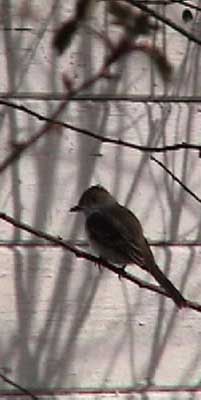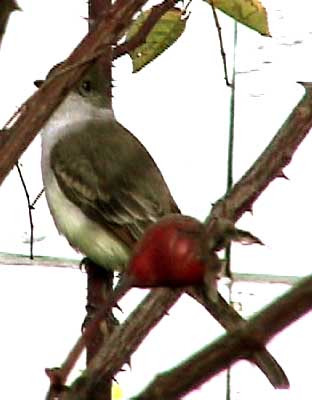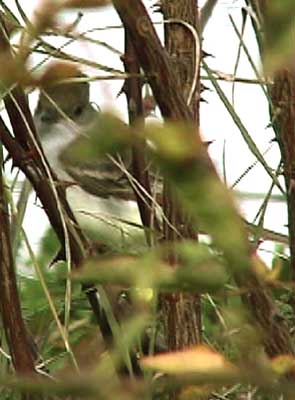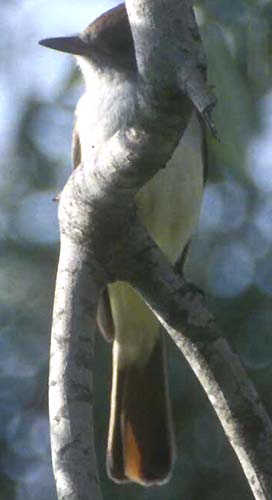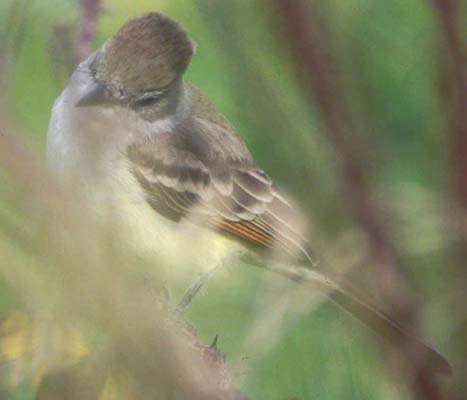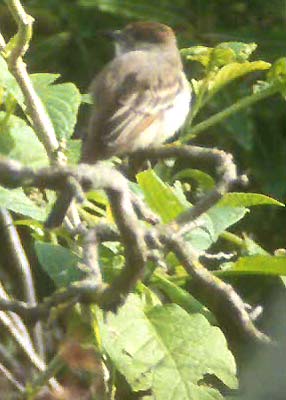A NUTTING'S FLYCATCHER IN SANTA CRUZ
COUNTY, CALIFORNIA
photos & text © 2003 Rita Carratello &
Don Roberson
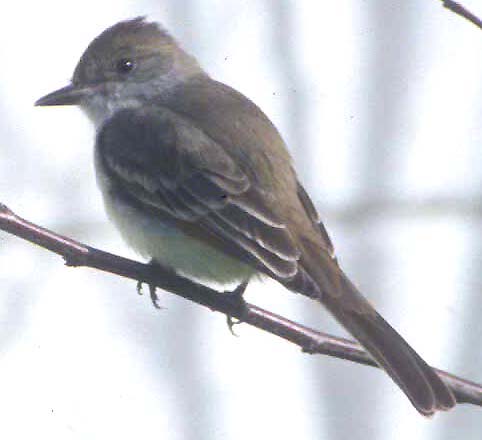 This
interesting Mexican flycatcher was found in the backyard of Rick and Barbara
Linzer in Santa Cruz on 1 Jan 2003 by Michelle Scott. As I understand the
story, it was thought to be a rare Myiarchus, possibly a Dusky-capped
Flycatcher M. tuberculifer; Steve Gerow and Madeline Spencer went
the next day to confirm the identification. Steve Gerow took some excellent
field notes and noted a number of problems for Dusky-capped Flycatcher,
including a wheet call, paler-edged secondaries than the rusty-edged
primaries, the tail pattern, and the fact that the bird was eating olives.
After an email exchange that evening, arrangements were made for a few
of us (Gerow, David Suddjian, Joe Morlan, Robbie Fischer, Dan Singer, Rita
Carratello and me) to visit the private residence the next morning (3 Jan)
to follow up on the possibility this might be a Nutting's Flycatcher M.
nuttingi. This is what it proved to be; primary credit, then, should
go to Michelle Scott and Steve Gerow.
This
interesting Mexican flycatcher was found in the backyard of Rick and Barbara
Linzer in Santa Cruz on 1 Jan 2003 by Michelle Scott. As I understand the
story, it was thought to be a rare Myiarchus, possibly a Dusky-capped
Flycatcher M. tuberculifer; Steve Gerow and Madeline Spencer went
the next day to confirm the identification. Steve Gerow took some excellent
field notes and noted a number of problems for Dusky-capped Flycatcher,
including a wheet call, paler-edged secondaries than the rusty-edged
primaries, the tail pattern, and the fact that the bird was eating olives.
After an email exchange that evening, arrangements were made for a few
of us (Gerow, David Suddjian, Joe Morlan, Robbie Fischer, Dan Singer, Rita
Carratello and me) to visit the private residence the next morning (3 Jan)
to follow up on the possibility this might be a Nutting's Flycatcher M.
nuttingi. This is what it proved to be; primary credit, then, should
go to Michelle Scott and Steve Gerow.
The bird appeared briefly at 8:30 a.m. on 3 Jan (before Rita and I arrived)
and did not reappear until 12:30 p.m., by which time Steve and David had
left. Once the flycatcher reappeared in its favorite olive tree, though,
we were able to study it off and on over the next half-hour, and obtain
excellent views and many photographs and video. We were able to meet with
Rick Linzer, the homeowner at 1425 Laurel where the bird was first found,
and make arrangements for future visitors. The bird eventually crossed
the street for additional close views, before flying off on an apparent
circuit elsewhere in the residential neighborhood. Some key points noted
were:
-
a smallish Myiarchus, perhaps the size of a phoebe, but larger than
experiences with Dusky-capped Flycatcher yet it seemed smaller than an
Ash-throated Flycatcher to me (obviously, neither around for comparison)
-
a distinctive sharp, short, pwik call, given often when it was vocalizing,
sometimes could be rendered as wick! This call is more like
the wheet! calls of some larger Myiarchus (e.g., Brown-crested)
than the mournful peeer of Dusky-capped, but was closer to a cross
between Downy Woodpecker and Least Flycatcher (i.e., between a pik
and a whit) than to any Myiarchus call that I know
-
bright orange mouth-linings, seen when eating olives (when bill closed
a thin pinkish strip is present at the gape)
-
the fact it was eating olives (although I understand it did eat some insects
later in the day)
-
a bill shape unlike the other Myiarchus under consideration, being
rather short and thick, rather than long and thin like Dusky-capped. This
short bill gives an entirely different jizz to the bird, not heavy-billed
like larger Myiarchus. It also means that although the bird seems
short-tailed at close range, at longer range it looks longish-tailed because
of the short bill
-
the classic wing-panel pattern that we learned from the Arizona and Orange
County birds: bright rusty edges to primaries, contrasting with lemon-yellow
edges to the outermost secondaries (these were more orangey-yellow at their
base), and then cream-colored edges to inner secondaries and tertials.
Tertial edges were crisply defined and some were quite broad, particularly
the innermost (uppermost on the closed wing). There were times, however,
when the tertials were held in such a manner as to cover the outer secondary
edges, and in that situation the yellow "mid-panel" was hidden
-
broad, and well-defined, creamy upper wingbar (tips of median coverts);
lower wingbar (tips of greater coverts) less defined but present
-
classic tail pattern, seen from below, with outer rectrix brown, that color
extending to tip of outer web and across the vane to merge with bright
rusty inner web, with the rusty color of the inner web extending all the
way to the tip of the rectrix (i.e., the brown tip to outer web does not
curl across to the entire tip of inner web, as it does on Ash-throated
Flycatcher)
-
pale grayish-white breast and sides of head, contrasting with bright yellow
belly/undertail coverts, all contrasting with pale brownish back, nape,
and crown (like all Myiarchus, the crown feathers were raised when
the bird was excited or agitated)
-
rusty-edged uppertail coverts
Most of us had experience with Nutting's Flycatcher in Mason Regional Park,
Orange County, in winter 2001-2002. Details about that first California
record are on Joe
Morlan's web site, and elsewhere
on this site. Some also had experience with another Nutting's Flycatcher
in southern Arizona in winter 1997-1998. Details of these records had been
reviewed before our visit on 3 January, and once the foregoing points were
noted, the identification as Nutting's Flycatcher was established to our
satisfaction.
Below are three stills from Rita's video that were posted the first
evening. They show some (but not all) of the useful characters for identification.
I now have my slides back (upper right shot on this page, and those
following, all © 2003 Don Roberson). These next two shots show many
of the key identification points for Nutting's Flycatcher, including the
tail pattern with the rusty inner web extending to the tip (left). The
full-frame shot (right) shows well some details of the upperwing coverts
but note that in this pose the tertials are held drooping and covering
the key 'mid-panel' character.
In the following two photos, however, one at very close range and the other
at a distance, the lemon-yellow edges to the outer secondaries form a contrasting
'mid-panel' between the rusty-edged primaries and the whitish-edged tertials
and inner secondaries:
Nutting's Flycatcher is found from central Sonora, Mexico, south to
northwestern Costa Rica (AOU Check-list, 7th ed.). It is generally considered
primarily a Mexican species and had been thought to be resident, although
obviously there is some movement that is not yet well understood. There
are three previous records for the United States:
-
8 Jan 1952 Roosevelt Lake, Arizona (specimen collected)
-
14 Dec 1997-21 Mar 1998 Patagonia Lake State Park, Arizona; a color photo
of that bird appears on the cover of Field Notes, Vol. 52, No. 2
(1998)
-
11 Nov 2000-26 Mar 2001 Irvine, Orange Co., California; a color photo appears
on the cover of Western Birds, Vol. 32, No. 1 (2001)
This Santa Cruz County bird is thus the second for California, and the
first for northern California. It surely must be considered a surprise
this far north.
We are grateful to those who reported this interesting bird, and to
the homeowners Rick & Barbara Linzer. Additional details and excellent
photos are available on Joe
Morlan's web page for this bird, and he has links there to yet other
photographic documentation.
TOP
GO TO MONTEREY
COUNTY PAGE
GO TO HOME PAGE
GO TO
IDENTIFICATION PAGE
GO TO BIRDING THE
WORLD PAGE
GO TO BIRD FAMILIES
OF THE WORLD
Page created 3 Jan 2003, updated 6 Jan 2003
 This
interesting Mexican flycatcher was found in the backyard of Rick and Barbara
Linzer in Santa Cruz on 1 Jan 2003 by Michelle Scott. As I understand the
story, it was thought to be a rare Myiarchus, possibly a Dusky-capped
Flycatcher M. tuberculifer; Steve Gerow and Madeline Spencer went
the next day to confirm the identification. Steve Gerow took some excellent
field notes and noted a number of problems for Dusky-capped Flycatcher,
including a wheet call, paler-edged secondaries than the rusty-edged
primaries, the tail pattern, and the fact that the bird was eating olives.
After an email exchange that evening, arrangements were made for a few
of us (Gerow, David Suddjian, Joe Morlan, Robbie Fischer, Dan Singer, Rita
Carratello and me) to visit the private residence the next morning (3 Jan)
to follow up on the possibility this might be a Nutting's Flycatcher M.
nuttingi. This is what it proved to be; primary credit, then, should
go to Michelle Scott and Steve Gerow.
This
interesting Mexican flycatcher was found in the backyard of Rick and Barbara
Linzer in Santa Cruz on 1 Jan 2003 by Michelle Scott. As I understand the
story, it was thought to be a rare Myiarchus, possibly a Dusky-capped
Flycatcher M. tuberculifer; Steve Gerow and Madeline Spencer went
the next day to confirm the identification. Steve Gerow took some excellent
field notes and noted a number of problems for Dusky-capped Flycatcher,
including a wheet call, paler-edged secondaries than the rusty-edged
primaries, the tail pattern, and the fact that the bird was eating olives.
After an email exchange that evening, arrangements were made for a few
of us (Gerow, David Suddjian, Joe Morlan, Robbie Fischer, Dan Singer, Rita
Carratello and me) to visit the private residence the next morning (3 Jan)
to follow up on the possibility this might be a Nutting's Flycatcher M.
nuttingi. This is what it proved to be; primary credit, then, should
go to Michelle Scott and Steve Gerow.
